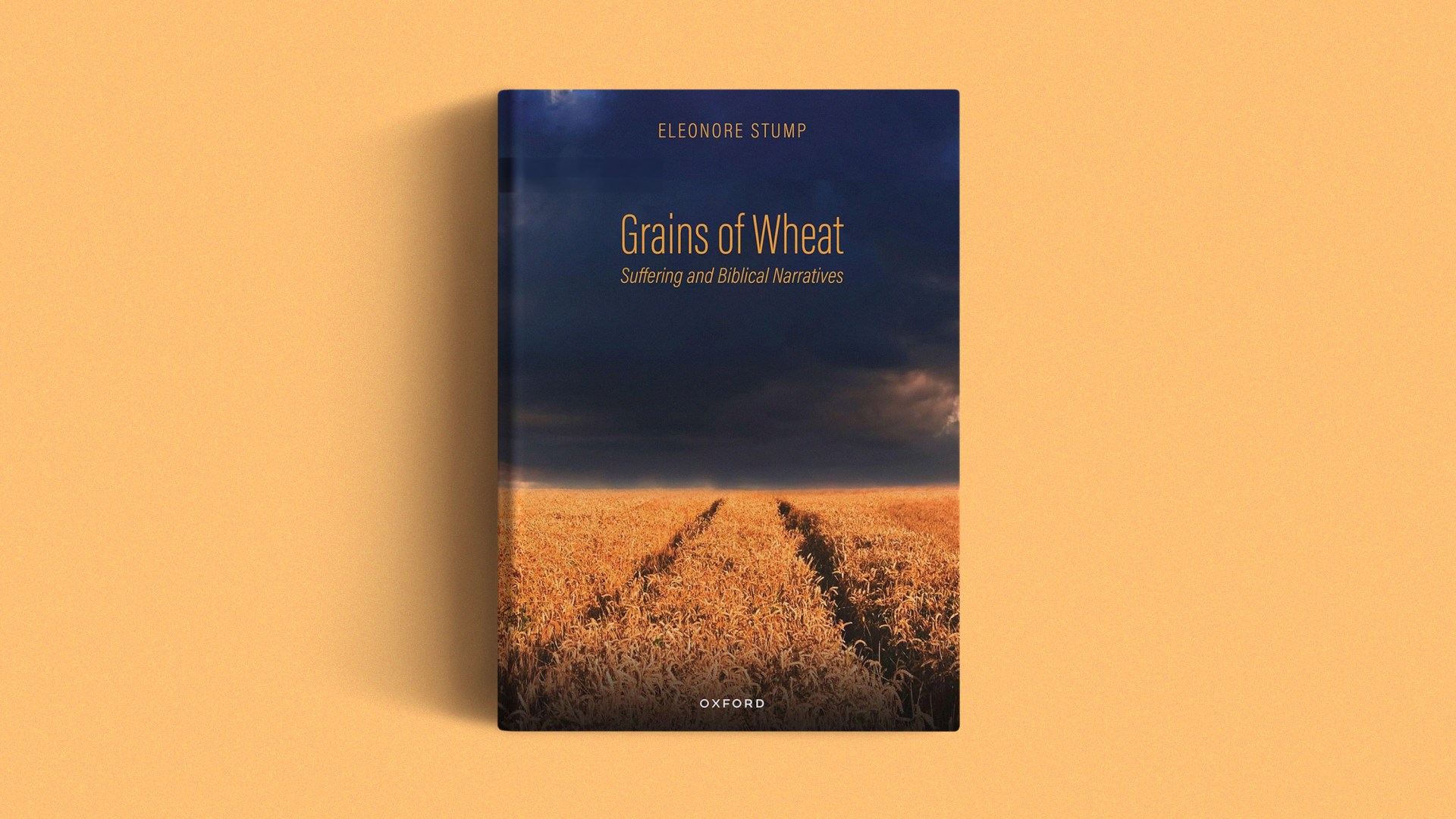Eleonore Stump is a connoisseur of suffering. To quote Hamlet’s anguished words, she knows the “thousand natural shocks that flesh is heir to,” which come in degrees, varieties, and combinations that bring ruin to human lives.
Grains of Wheat: Suffering and Biblical Narratives (Oxford Studies in Analytic Theology)
Oxford University Press, USA
448 pages
$21.66
Some sufferings arise because the human heart desires goods that are fragile or uncertain. Other sufferings arise because our own evil acts harm ourselves and others. Still others come about without guilt, resulting from natural tragedies which God permits for reasons unknown and mysterious. Then there is the suffering that disqualifies a person from the intimacy of relationships through a pervasive sense of shame.
If God intends to wipe every tear from every eye, then it stands to reason that his means for doing so must be as varied as the sorrows themselves. In Grains of Wheat: Suffering and Biblical Narratives, Stump, a philosopher of religion, argues that stories from Scripture provide insight into God’s plans for defeating the assorted forms of suffering that afflict those who love him.
Reading biblical narratives in this way is hardly uncontroversial. It can be tricky to derive broad philosophical insights from specific narratives—especially historical accounts that consist of so many contingent and unrepeatable details.
Aristotle once said that poetry “is a more philosophical and a higher thing than history” since poetry deals in universal truths whereas history records particular events. Modern biblical scholars, employing historical-critical interpretative methods, seemingly agree with this perspective. Much of their work involves parsing biblical narratives into layers of accretion and redaction, thereby reducing the scope of interpretation to the author’s original historical context.
By contrast, many premodern Christian thinkers viewed certain biblical characters as allegories of particular virtues, rather than complex bundles of personality and psychology like any other human beings. Likewise, many preachers, tasked with making biblical narratives lively and interesting to contemporary congregations, feel tempted to reduce Bible figures to character sketches or morality fables. Think, for instance, of sermons that exhort, “Dare to be a Daniel!” or offer “Lessons in Leadership from the Life of Esther.”
Stump, for her part, works to avoid these habits. As she considers what biblical narratives tell us about suffering, she refrains from deriving universal lessons, crafting simple allegories, or limiting her insights to time-bound historical details. Instead, she assumes that these stories are as they appear, unitary accounts compiled with great and evident artistry. And she proceeds to ask what they can teach about suffering, in all its varieties, and God’s work to defeat it.
Defeating suffering, Stump writes, means arranging things so that “a good … comes primarily to the sufferer, that greatly outweighs the suffering, and that could not be gotten without the suffering.” This is a twist on what theologians sometimes call a felix culpa theodicy, referring to the notion that humanity’s fall into sin led to blessed outcomes (like the redemptive work of Christ) that would have been impossible without it. Stump takes this viewpoint, typically applied to humanity as a whole, and tailors it to each individual who suffers. In her view, God is no utilitarian who allows evils in the lives of some to bring about a greater good for a larger number. Instead, he allows suffering in the lives of those who love him so that he might defeat those evils and bring about greater goods for each one individually.
Notice, of course, that this picture of defeating suffering does not involve preventing its occurrence or even lessening its sorrow. This will come as no surprise to sufferers. The Bible is more often the story of suffering turned to some good than suffering avoided. Theodicy may soothe the intellect, but it rarely binds up the wounds of the soul.
Yet here is where we see the advantage of grounding a philosophy of suffering not merely in propositions about God’s nature but also in narratives about his work of healing and restoration. Consider this in the context of our relationships with other people. Propositions yield only the most superficial acquaintance. The deepest kind of knowledge comes through stories. A proposition about my grandfather (“He was courageous”) does not capture his personality nearly as well as a narrative from his life (“After parachuting into France on D-day, he was captured by the Nazis and escaped from their prison camp by singing German opera with his captor”).
Biblical narratives afford insight into the personalities of all the actors in the story, including the foremost actor, God. In other writing, Stump has distinguished between what she calls “Dominican knowledge,” the propositional kind cherished in the Dominican Order’s analytically rigorous theology, and “Franciscan knowledge,” a kind that is most characteristic of intimate relationships.
Scripture captures something like this distinction in Job’s culminating exclamation, which itself comes in the course of a narrative: “My ears had heard of you but now my eyes have seen you” (42:5). Job, of course, had not literally seen God with his physical eyes. Instead, he alludes to a newer and deeper familiarity gained by living in the narrative God had written for him. Ask the oldest and holiest members of your congregation what they’ve learned about God, and they will probably begin telling stories.
Stump herself blends these two types of knowing. She is the rare academic about whom hagiography is not uncommon. A senior philosopher of religion once described her to me as “terrifying holy,” which he attributed to her practice of rising each morning at 4 a.m. to pray. Her writings on the Bible give off a palpable radiance, suggesting someone who has seen the living God and come away limping but unscathed. They demonstrate an attention to detail and a power of psychological insight that attest to decades of a just and loving gaze at Scripture.
I first heard Stump describe her method of reading the Bible at a conference in Jerusalem on interpreting Hebrew Scripture. More than any other education or training, that conference influenced the way I read the Bible, because the Jewish scholars there approached their work with the conviction that every narrative detail, explicit and implicit, reveals something important.
Take, for example, the first time Scripture names God as Jehovah Sabaoth, meaning “Lord of Armies.” This occurs in the first chapter of 1 Samuel, where Hannah prays for a son. Why does she invoke this name for the first time in Israel’s history when asking for relief from her infertility? According to the Jewish scholars at the conference, she did so to present God with a kind of logical appeal: Oh, God, you have so many men at your disposal. Can’t I just have one?
Stump is masterful at drawing out these sorts of details and subtle textures. Consider her account of Mary of Bethany (the New Testament sister of Martha). Of the sisters, Mary is undoubtedly the most familiar with Christ. Yet she does not hasten to Christ after the death of her brother Lazarus, as does the more distant Martha. As Stump argues, Mary hesitates because Christ needs to make the first move, demonstrating to Mary that she is as important to him as he is to her.
Stump is similarly insightful in discussing the sufferings of Abraham, which she attributes to “the desires of his heart”—namely, his desire to be not just a father but a patriarch. As Stump observes, this makes him “double-minded about the fulfillment of God’s promises, at least to the extent of providing a back-up plan for God, in case the original plan fails.”
After Sarah’s death, Abraham marries a woman named Keturah, who bears six additional sons as a kind of insurance policy against the potential failure of God’s promises. Abraham was planning to fulfill these promises by his own strategies, since Rebekah was barren for the first two decades of her marriage to Isaac. Only after she gives birth to twins does Abraham feel confident enough in God’s provision of offspring to send Keturah and her sons away, ensuring that Issac alone will carry the covenant forward.
Taken as a whole, the chapters of this book, each previously published elsewhere but compiled here for the first time, form a kind of narrative and argument. The first four chapters—on Job, Samson, Abraham, and Mary—give a taxonomy of different forms of suffering. As Stump argues, God intends to defeat these sufferings through a process of salvation that will itself include sufferings.
To develop this theme, then, she devotes the next two chapters to Christ, the suffering God who triumphs over suffering first by overcoming temptation in the wilderness, then by overcoming death itself in Gethsemane and on Calvary. Then follows a chapter on Ecclesiastes, a book whose first-person, narrative shape often goes overlooked. In the chapter, Stump reflects on how humans after the Fall might “flourish as embodied creatures of a good Creator in the parts of their lives lived in the earthly realm.”
The book concludes with an autobiographical chapter about Stump’s own experience with suffering, reflecting on what she calls “goodness of the heartbreaking kind” and showing how this is a vestige of God’s continued presence in the world. As she argues, our acquaintance with evil, even simply by reading the news, offers a kind of preparation for the gospel.
“The mirror of evil,” Stump writes, “can also lead us to God.” She continues,
A loathing focus on the evils of our world and ourselves prepares us to be the more startled by the taste of true goodness when we find it and the more determined to follow that taste till we see where it leads. … There are some people, then, and I count myself among them, for whom focus on evil constitutes a way to God.
God does intend to defeat evil in the lives of those who love him. Stump does readers a great service by showing that this has been his intention all along. If the narratives of the Bible are any indication, he is quite good at it.
Justin R. Hawkins is a postdoctoral researcher in bioethics at Columbia University Irving Medical Center.





















